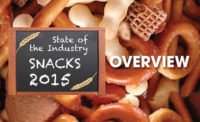Snacking is a way of life in America. As Mintel notes in its May 2017 “Snacking Motivations and Attitudes—U.S.” report, nearly everyone in America snacks every day. Of the 94 percent of people who snack during the day, half snack two to three times per day. Also, Mintel found that 70 percent of people nowadays believe that “anything can be considered a snack.” And while the research found that one-third of people claim to be snacking healthier than before, over 60 percent of people snack in order to satisfy a craving.
It’s simply a byproduct of our existence. Many of us often find ourselves too busy for a traditional meal. So we seek snacks to fill the nutritional gap. As a result of this concentrated focus, the importance of the snack market continues to grow.
Overview | Chips | Puffed/Extruded Snacks | Popcorn | Snack Mixes & Nuts | Tortilla Chips | Pretzels | Frozen Snacks | Crackers
We seek different types of snacks at various times of the day to fulfill distinct needs. Nutritional snacks can stand in for a more-traditional meal. Indulgent snacks and satisfy a craving. Emotional drivers also often factor into snack decision-making.
And each generation of consumers brings its own set of motivations toward snacking. Mintel found that millennials tend to snack more than any other demographic, with one-quarter snacking four or more times per day. They snack to fill an emotional need or because they are stressed. They also snack to stay focused throughout the day and maintain their energy levels.
This ever-evolving culture of snacking brings unique challenges to the industry, and provides multiple opportunities for business development.
“Because snacking has increasingly become a functional part of consumers’ daily diets, the category is no longer characterized by its traditional definition, but has spread throughout every aisle in the grocery store and sold through every retail channel,” says Elizabeth Avery, president and CEO, SNAC International, Arlington, VA. “That trend has continued this year.”
As the very definition of what constitutes a snack continues to change shape, U.S. consumers are seeking a range of snacking options, often with a greater emphasis on health and nutrition than at any point in history—but never at the expense of eating enjoyment.
“As IRI’s Sally Lyons Wyatt noted at SNAXPO18 last March, the snacking category is growing with consumer lifestyle demands and crossing product lines,” says Avery. “In fact, the snacks category has crossed into product sectors we haven’t seen before, such as collagen and energy-infused snacks.”
In her SNAXPO18 presentation, “New and Emerging Snacking Trends,” Lyons Wyatt, executive vice president and practice leader, IRI, Chicago, cited three snack products that included grass-fed collagen, in a nut and seed butter bar, a cookie bar, and a coconut and cashew bar.
Lyons Wyatt also noted that “macrosnacking” has grown to include four primary snack food segments:
- Wellness—products that are inherently healthier and/or have nutrition claims
- Permissible indulgence—products consumers feel are more permissible because they have added benefits and/or reduced negatives
- True indulgence—“fully loaded” traditional products
- Treats—mainly confections
IRI has noted strong growth in plant-based snacks, such as snacks featuring higher levels of plant-based protein from ingredients like soy, rice and pea protein. Lyons Wyatt also pointed toward the growth of paleo-friendly snacks, specifically discussing the distinct rise of coconut ingredients in the products. Probiotics are also going into more snack foods these days. (Sally Lyons Wyatt and Elizabeth Avery will deliver snack keynote presentations as part of the free Snack Food & Wholesale Bakery “2018 State of the Industry: Snack & Bakery” webinar taking place on September 6 at 2:00 p.m. EDT; registration is open at www.snackandbakery.com/webinars.)
Our snacking landscape has grown to feature a strong balance of options—spanning everything from health-and-wellness snacks to indulgent treats. “Considerable innovation continues to drive the category, with fresh fruits, vegetables, yogurts and sweets complementing the continued strength of the traditional, savory snacks segment,” says Avery. “Because consumers continue to replace meals with snacks, they are demanding snack options that include attributes such as vitamins and minerals, protein, natural ingredients, whole grains, and more. This has led to growth in categories such as plant-based snacks, paired products such as meat and cheese, bars, and probiotics snacks.”
Regulatory matters
Industry leadership continues to help define the future of snacking at the federal level. “Last summer, we were successful in obtaining an extension for the compliance deadline for the Nutrition Facts labeling rules, which has since been finalized for January 2020,” reports Avery. “This extension was crucial to allow our members the necessary time to redesign the Nutrition Facts panel on every single SKU, use existing packaging to save millions of dollars’ in wasteful spending and, we hoped, to provide FDA with the additional time to finalize important implementation guidance.”
Discussion surrounding GMOs continues to intensify, and leadership continues to work toward establishment of a reasonable federal approach toward labeling. “We spent considerable resources in the last year urging the USDA and the Office of Management and Budget to accelerate the rulemaking for Bioengineered Disclosure,” says Avery. “Our intent was to ensure our members can coordinate packaging updates to the greatest extent possible. While USDA has issued a proposed rule, the final regulation is not expected to be finalized for many more months, perhaps into 2019. SNAC International is also a member of the steering committee for the Coalition for Safe Affordable Foods, a broad coalition representing the ag-value chain from farm to shelf and has been working to forge consensus positions across the value chain, as well as prepare our own category-specific comments.”
Millions of Americans rely on some federal assistance for their food shopping budget. “A top priority for SNAC International and its members is to protect the integrity of the Supplemental Nutrition Assistance Program (SNAP) as Congress began the process of its five-year renewal of the Farm Bill,” says Avery. “SNAC, along with its partners in the food, retail and hunger community, has worked to ensure that participants in the SNAP program are free to choose what foods they buy. A good food/bad food list would be nearly impossible to determine, immensely costly to maintain and would create a bureaucracy that would not save taxpayers money.”
The subject of accurate and consistent product labeling continues to rise in importance as states pass their own requirements in the absence of a federal mandate on some issues. “SNAC International is a member of the Coalition for Accurate Product Labels, which is a group of organizations working to ensure that state and local labeling requirements are risk-based and warranted by sound science,” says Avery. “Because no SNAC member, big or small, does business in just one state, it is vital for new labeling requirements to follow a strong scientific standard. A state patchwork of labeling laws will only confuse consumers and create unnecessary costs for manufacturers.”
In June, Congress proposed the Accurate Labels Act, which would put a structure and requirements in place for new labeling mandates proposed by states and municipalities, notes Avery. “Our members advocated for the bill during more than 100 meetings with lawmakers as part of the annual Legislative Summit.”
Workforce development
In order to sufficiently fuel growth, the industry must address aspects of the workforce that have grown problematic. One key issue is the driver shortage. According to the 2017 “Truck Driver Shortage Analysis” from the American Trucking Associations, the transportation industry currently has a shortage of an estimated 50,000 drivers. This is forcing increases in transportation costs.
“The issue of transportation costs has become very important,” says Avery. “Caused in large part by a shortage of drivers, freight costs have skyrocketed, and SNAC International is working with our partners on Capitol Hill to advance potential solutions that would help make the commercial driving profession more attractive to the workforce.”
The snack industry also must continually work toward developing the talents of the leaders of tomorrow. To that end, SNAC International partners with its members in the area of professional development. “One of the primary ways we deliver value to our members is through providing educational programming at no additional cost beyond membership dues,” says Avery. “Over the last three years, one of our highest-rated programs has been the ‘Emerging Leaders Program,’ a 2.5-day professional development course led by MBA professors at Georgetown University.” The next “Emerging Leaders Program” will take place November 14 to 16.
Following the success of this program, SNAC International hosted an “Emerging Leaders Program 2.0” event in June, a next-level program that builds upon the content presented in the “Emerging Leaders Program,” with expert-led discussions sessions that included:
- “Teamwork in Action: Collaborate to Innovate”
- “Ethics in Actions: A Managerial Perspective”
- “Personal Branding”
- “Managing Relationships at Work: Building and Maintaining Trust”
- “Inspiring Your Team to Greatness: The Power of Storytelling”
The snack industry will only continue to grow in importance as a vital part of the American diet. And equipping the industry leaders of tomorrow with the right informational resources is the first step on the pathway toward success.
Overview | Chips | Puffed/Extruded Snacks | Popcorn | Snack Mixes & Nuts | Tortilla Chips | Pretzels | Frozen Snacks | Crackers





